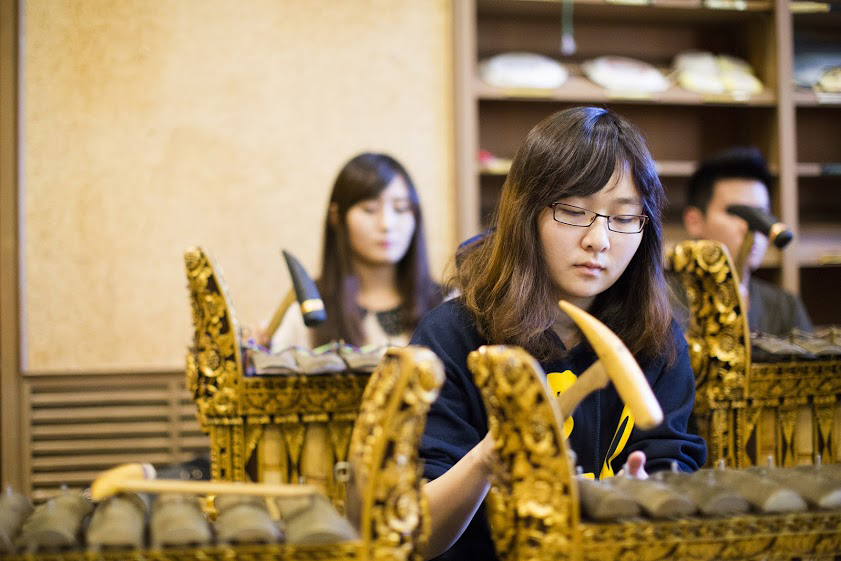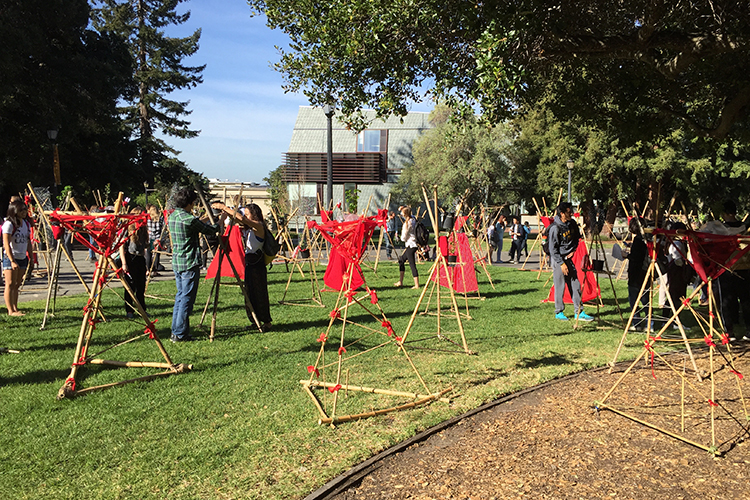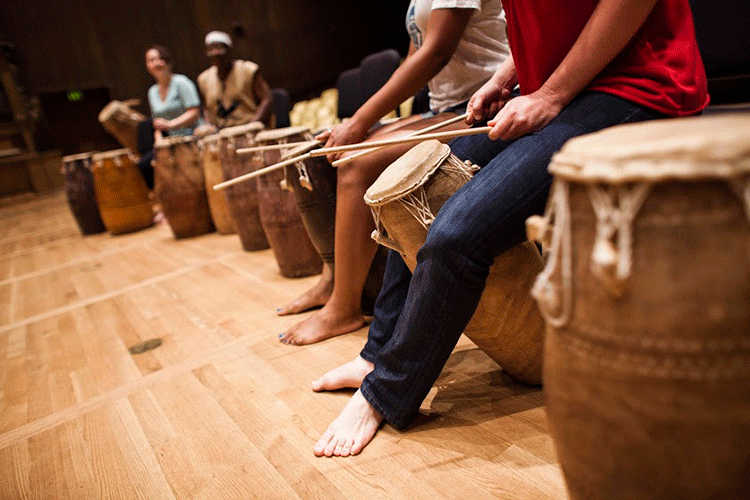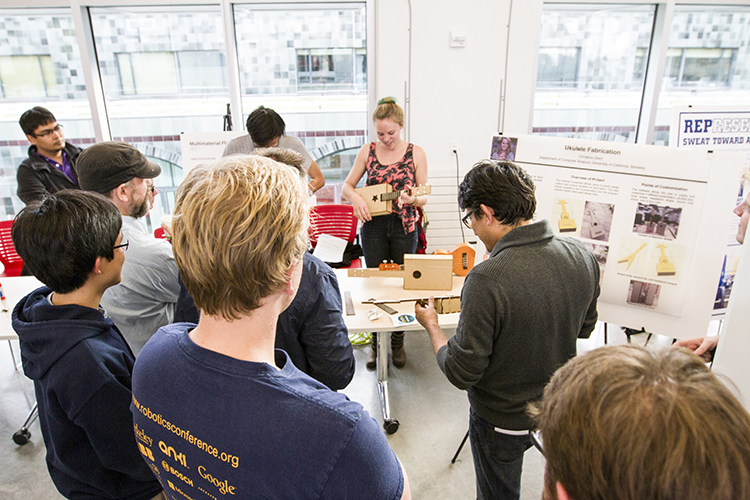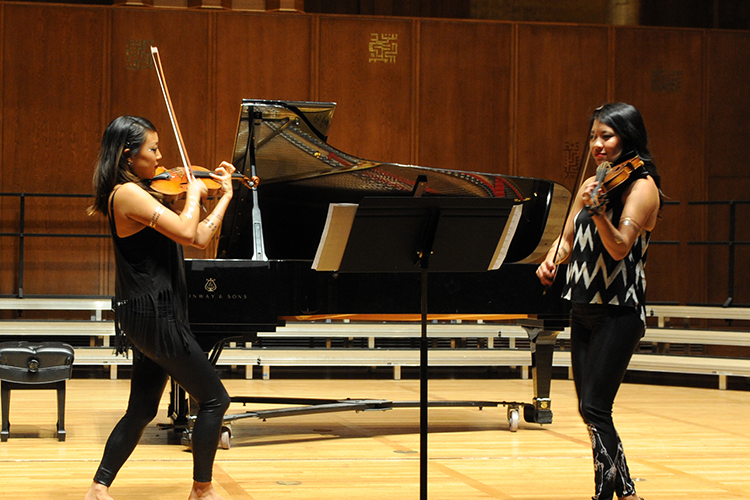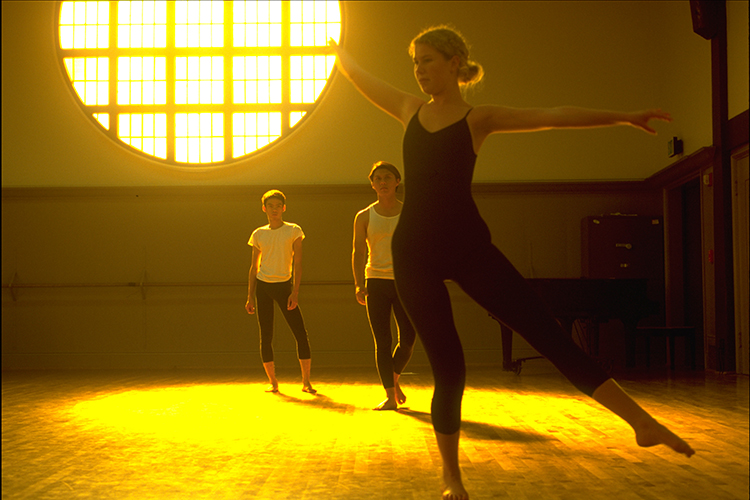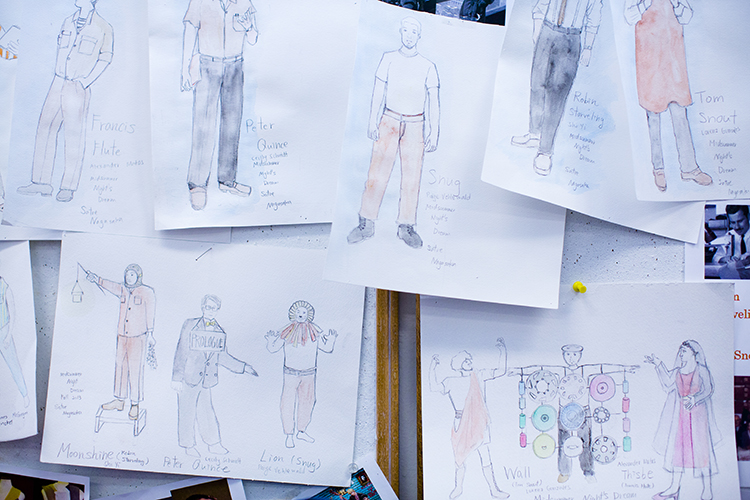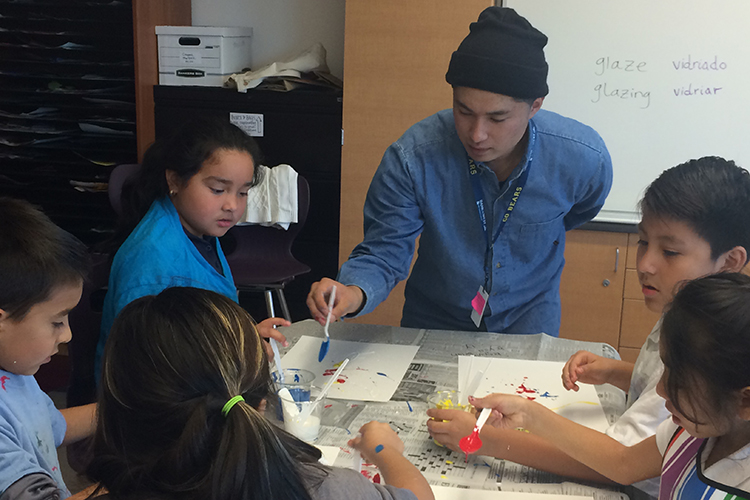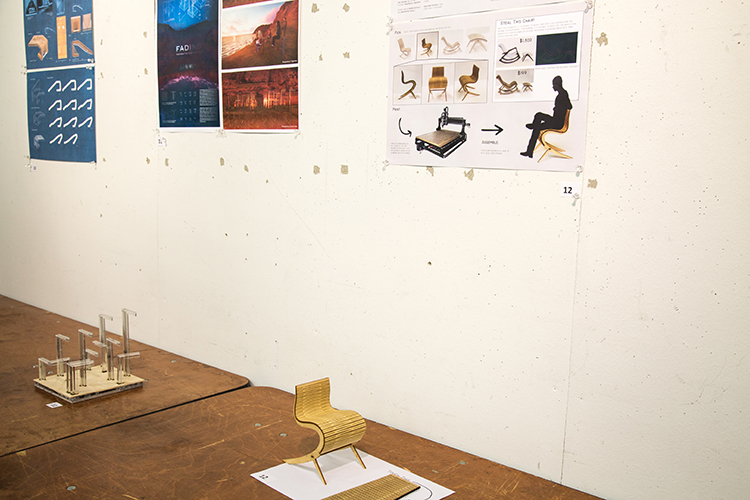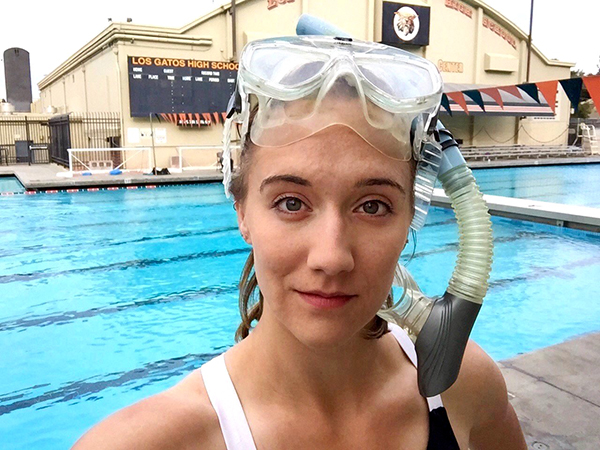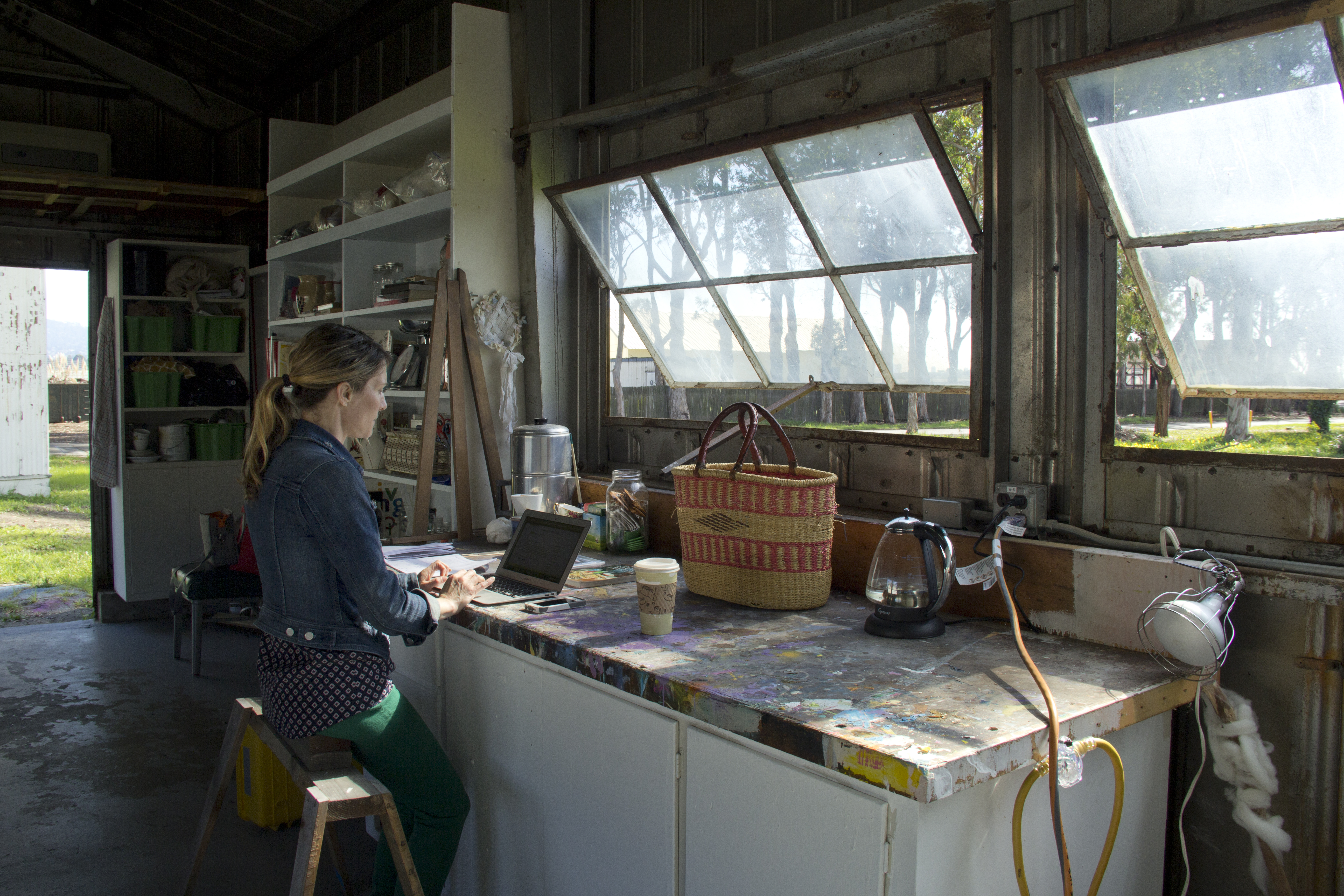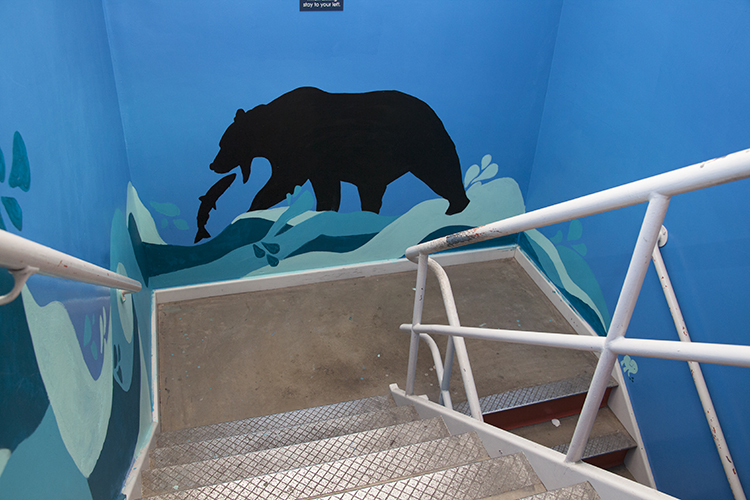Major new effort to elevate Berkeley’s creative culture
A new Arts + Design Initiative has launched at Berkeley and emphasizes the key role that creativity plays in higher education
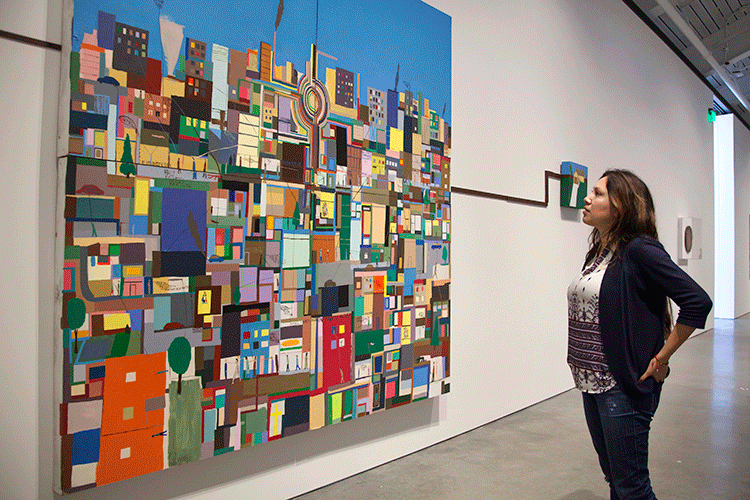
March 10, 2016
Seniors Brenda Romero and Andrew Wong will graduate from UC Berkeley in May, but not until this semester had they set foot in the Berkeley Art Museum and Pacific Film Archive (BAMPFA) or attended a dance, theater or musical performance in Zellerbach Hall.
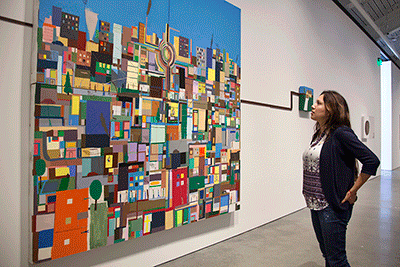
In BAMPFA, senior Brenda Romero admires a Chris Johanson painting, “Cityscape with House & Gray Energy.” (UC Berkeley photo by Brittany Murphy)
Just a few months into a new course that’s immersing about 80 undergraduates from many academic disciplines in the arts and design, that’s all beginning to change. So is the students’ awareness of and appreciation for these fields at Berkeley, a public research university often best-known for STEM (science, technology, engineering and math).
“I wish I’d had this class earlier in my undergraduate career,” says Wong, a pre-med student who brightens talking about the use of birdsong by French composer Olivier Messiaen in a work the class heard performed at Zellerbach by the St. Louis Symphony. Wong also is discovering links between art and science, like the use of harmonics in both physics and music.
Romero, a psychology major, heard her first lecture by an architect, Charles Renfro of Diller Scofidio + Renfro, the firm that designed BAMPFA, and was so excited she told her parents. Introduced as a child primarily to the arts and crafts of Mexico, where her family has its roots, she recently co-led a class discussion about the value of studying many cultures.
“This course is making me appreciate buildings, paintings, everything I see. We are surrounded in life by art,” says Romero. “I appreciate the world more as a result of taking this course; it’s broadened my horizons, given me a new outlook.”
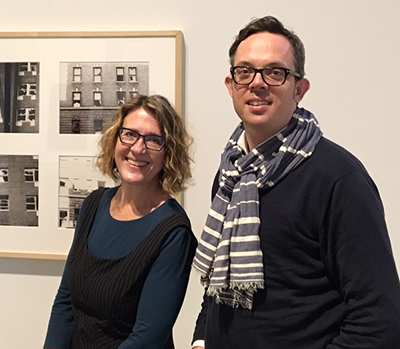
Professors Shannon Jackson and Nicholas De Monchaux are co-teaching a new Big Ideas class headquartered at BAMPFA. (Photo by Lauren Pearson)
That’s a goal not only of the new Big Ideas course, “Thinking Across the Arts and Design at Berkeley,” but of a major new effort at Berkeley called the Arts + Design Initiative. Its many ambitions include making exposure to the arts and design essential to the undergraduate experience, developing students’ creative skills for today’s workplace and establishing Berkeley as a world-leading arts institution.
“The arts play a vital role in higher education, in producing creative people prepared for the future,” says Shannon Jackson, Berkeley’s first associate vice chancellor for the arts and design and a teacher and co-creator of the new Big Ideas course. Also on her to-do list is a multi-disciplinary creative curriculum, a “Berkeley culture pass” that subsidizes arts events for students, and more and updated campus arts facilities.
“Studying the arts and design at a public research university like Berkeley is different from studying at a traditional art school or conservatory,” says Jackson, a professor of rhetoric and of theater, dance and performance studies. “We don’t want to create a separate arts quadrant, but to elevate an arts orbit; the arts permeate the entire university. It’s an organizational challenge, but it’s time to bring more visibility to this incredible creative culture.”
Arts encounters vital for undergrads
Jackson’s post is part of an ongoing effort by Chancellor Nicholas Dirks to enhance and evolve the undergraduate experience at Berkeley. The university’s vision for an updated, comprehensive liberal arts education now includes “integrating art encounter, art inquiry, art-making and design into the fabric of student life,” according to Dirks’ wide-ranging 2015 report on key campus priorities. Creative, literate, numerate and investigative are the four key competencies he wants all Berkeley students to master.
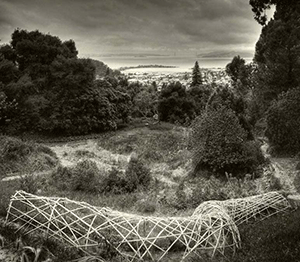
This child-size tunnel, woven from reclaimed timber bamboo, was designed and built at Blake Garden by UC Berkeley undergraduates. (Photo by Geoffrey Agrons)
Eroding for decades in many K-12 public schools, arts education increasingly is tied to significant gains in everything from academic performance, critical thinking, verbal skills and motivation to confidence, compassion, teamwork and deeper connections to the world.
The majors that college students choose can be demanding and limit opportunities to explore other topics. Currently, more than 40 percent of Berkeley undergraduates graduate without having taken an arts or design course in fields including art practice, art history, music, theater, dance, photography, film, journalism or architecture.
The Arts + Design Initiative will further embed creativity into existing curriculum and into extracurricular structures like undergraduate research apprenticeships, internships, capstone and mentorship programs, work-study positions and public service.
Jackson hopes the Big Ideas arts course will be team-taught each year by different pairs of professors; the course has received approval to fulfill undergraduates’ breadth requirement, placing it at the core of the educational experience.
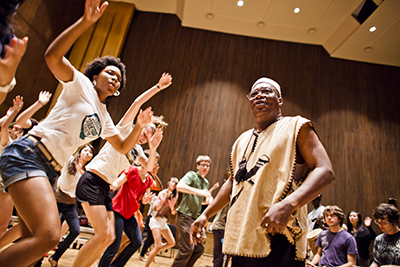
The African Music Ensemble class emphasizes the music of Ghana and is taught by Ghanian musician C.K. Ladzekpo. (UC Berkeley photo by Elena Zhukova)
“We want students’ imaginations to be continuously cultivated by encountering new objects and events,” says Jackson, adding that such encounters “are keys to understanding different peoples and cultures.”
“Each student also needs the chance to take the risk as a creator and to make something that wasn’t there before,” she adds, “to feel transformed and even to transform the world in a new way.”
Arts and design skills are vital to preparing students for the workforce, says Nicholas De Monchaux, an architecture professor in the College of Environmental Design (CED) who is co-teaching this spring’s Big Ideas course with Jackson.
“Our undergrads were 10 years old during the 2008 recession, and grew up with work being unstable,” he says. “They’re concerned about having the right skills to cope with an uncertain job market, and creative skills like design thinking and crafting compelling images and presentations are not only helpful in getting work, they are helpful in rethinking and re-imagining new ways of working.” (Story continues after slideshow.)
Mapping a vast arts orbit
Arts and design courses may not be listed on every undergraduate’s class schedule, but that doesn’t mean artistic creativity isn’t thriving at Berkeley. Across the entire campus, it’s a noticeable part of daily life in outdoor plazas, studios, maker spaces, practice rooms, classrooms, labs, museums, gardens and performance halls.
“It’s all spinning in unconnected bits across campus,” explains Anthony Cascardi, dean of arts and humanities in the College of Letters and Science, who led a visioning process for the future of the arts at Berkeley. “But the initiative will be the glue to bring everything into coordination; the whole will be far greater than all its parts.”
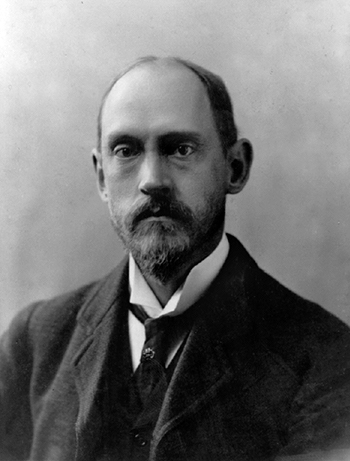
John Galen Howard, founder and director of the School of Architecture from 1903-1926, believed in the integration of artistic culture and technology. (Photo courtesy of UC Press)
Jackson admits that, at the start, a big part of her job will be to conduct and publicize an inventory of this activity, and of the notable faculty and alumni in the arts and design, “so that it can be used to explain Berkeley’s creative culture and claim its centrality to Berkeley’s identity, to how Berkeley talks about itself and to how people talk about Berkeley.”
Sure to be included are architects John Galen Howard and Julia Morgan, writer Joan Didion, sculptor Mark di Suvero, actors John Cho and Chris Pine, chef Alice Waters, composer Mason Bates, choreographer Joe Goode and Apple co-founder Steve Wozniak, “but that’s just scratching the surface,” Jackson says. She adds that 62 current faculty members have received the prestigious Guggenheim Fellowship, which honors exceptional capacity either for productive scholarship or creative ability in the arts.
Students’ appetite for the arts is boundless, whether curricular or co-curricular. Introductory art courses are chronically oversubscribed, more than 225 student groups have an arts and design focus, and in the Department of Music, more than 5,000 students are in music classes and ensembles, up from about 3,000 a decade ago.

Students in an interactive design class at the Jacobs Institute for Design Innovation test out a glove for a video game controller assignment. (College of Engineering photo by Preston Davis)
At the Jacobs Institute for Design Innovation, diverse student teams in maker spaces explore the intersection between engineering, design thinking and the arts by learning prototyping, iteration and fabrication, with the goal of finding solutions that benefit people and society.
Berkeley’s passion for public service also is evident in CREATE, in which Berkeley students teach art to more than 200 youngsters in local after-school programs. During the regular school day, some 400 children benefit from Bridging the Arts, a program developed by the Department of Art Practice that places Berkeley art students in East Bay K-8 schools where art has been cut.
In addition to more than 475 courses offered by campus art departments, students are choosing from more than 200 De-Cal courses, many focused on the arts and design. Taught by students, for students, and currently attracting about 8,000 undergraduates a year, offerings include making music videos, Greek folk dance, Chinese calligraphy, Bob Dylan’s lyrics, Hayao Miyazaki films, 3-D modeling and animation, Korean drumming and Egyptian hieroglyphs.
“If students can’t find a space for their artistic passion, they create one,” says Elizabeth Keithley, assistant director of the Student Learning Center and the student instructors’ adviser.

Michelle Elizabeth, a psychology major, tries her hand at drawing a pelvis in the De-Cal art anatomy class. (UC Berkeley photo by Josephine Wu)
Science majors Erin Kaya and Heather Ruiz love the visual arts. “But none of Berkeley’s practice of art classes fit into our pre-med schedules,” says Kaya, “so, we started our own De-Cal class to show that the intersection between art and science is important.”
In their evening art anatomy course, Kaya and Ruiz teach physiology via drawing anatomically correct human bodies from the inside out — bones, muscles, nerves and organs. Their first class, last fall, had 30 seats and 100 email inquiries, and 70 students showed up. This semester’s class is even bigger, with a long waiting list.
Facilities to match the passion
A vibrant arts campus requires adequate facilities for teaching, research and performance; Berkeley needs both new and updated spaces. That means, for example, more flexible areas for dance, music and theatrical rehearsals and productions. Cal Performances’ Zellerbach Hall and the Department of Theater, Dance and Performance Studies’ Playhouse and classrooms, all built in 1968, require extensive re-imagining to bring spaces up to Americans with Disabilities Act (ADA) codes and to equip them with 21st century technology.

Theater, dance and performance studies students work on a costume for “A Midsummer Night’s Dream.” (UC Berkeley photo by Elena Zhukova)
Hertz Hall, a 1950s-era performance space known for its excellent acoustics, is “showing its age,” says Cindy Cox, chair of the Department of Music. So is Morrison Hall, the music department’s teaching, rehearsal, office and storage building. Cox adds that there’s a pressing need to repair the department’s 58 concert hall, classroom and practice pianos.
“The fact that the state has stopped funding seismic upgrades means we haven’t been able to renovate or expand our aging arts infrastructure,” says Jackson, “and improvements now have to rely on philanthropic rather than public dollars.”
“Our students and faculty persevere creatively despite these cuts,” she adds. “Even without adequate infrastructure, they produce exceptional work in every nook and cranny of our physical plant. But they deserve better.”

Conceptual illustration of a new look for Dwinelle Annex. (Mark Cavagnero Associates)
Jackson is encouraged by the addition last August of the College of Engineering’s Jacobs Hall, by the new Logan photography galleries at the Graduate School of Journalism and by BAMPFA’s opening in January. The Flex Studio Campaign at CED is under way to update the college’s 50-year-old design instruction facilities on six floors of Wurster Hall.
Another capital campaign will focus on renovating historic Dwinelle Annex, the former studio of John Galen Howard, as an arts and design hub. The hub would contain flexible galleries for exhibition, convening, screenings and media production, as well as studios for faculty and visiting artists-in-residence to work.

Sitting beside a BAMPFA mural project by Chinese artist Qui Zhijie, senior Andrew Wong writes in his journal. (UC Berkeley photo by Brittany Murphy)
If the effect on students of the new Big Ideas course in BAMPFA is any indication, the right setting can be very inspiring.
Romero says she’s discovered a 2003 painting by Chris Johanson in the museum’s 25,000-square-foot exhibit space that embodies her memories of growing up in San Francisco’s Mission District, “with all the lively colors around me coming from murals, shops and people.”
Wong, who as a boy didn’t appreciate his piano and art lessons, is playing the piano again, and one of his sketchbook drawings – the course requires journaling – was highlighted in class. That drawing was sparked by a class trip to Rice, a Cloud Gate Theatre of Taiwan performance at Zellerbach Hall.
“I really appreciate the opportunities this class provides me,” says Wong. “It lets me set aside a slot of time to step back, discuss perspectives on the arts with people from different backgrounds and appreciate life in new ways. “
